Updated 2/1/2022: The newest recommendation from the CDC advises that N95 masks offer the highest level of protection with well-fitting disposable surgical masks and KN95 face coverings also offering significant protection. Loosely woven cloth masks or even cloth masks with multiple layers of tightly woven, breathable fabric provide some protection (and are better than no mask) but are not recommended by the CDC as they are not as effective as surgical or N95 face coverings. With any mask, it’s important to wear your mask consistently and correctly to ensure the maximum amount of protection. All masks should be tightly fitted and cover both the nose and mouth and you should not feel any air escaping the sides or top of the mask when you exhale. Any mask is better than no mask and they are a critical, easily accessible tool to prevent the spread of Covid-19. It’s recommended that individuals wear the most protective mask they can to help keep themselves, and others, safe
As you’ve likely noticed, there are a variety of face coverings to choose from - each bringing their own unique set of strengths and limitations to the table. For safety and sanitation purposes, it is important to seek out masks and face coverings that come individually packaged. The right mask ultimately depends on both how you’re planning to use it and what level of protection you’re hoping for your mask to provide. To start, it’s best to be familiar with the two key concepts the CDC recommends in terms of maximizing the effectiveness of your mask.
- Having two or more layers of washable, breathable fabric - A mask with layers will stop more respiratory droplets from getting inside your mask (as well as keep your own droplets from escaping if you are sick). If you’re unsure if your mask has layers, you can double up yourself by layering a disposable mask underneath a cloth mask to get the same effect (do not layer two disposable masks as they are not designed to fit tightly to benefit from this layering). Because the droplets remain on the mask as they are captured, it is important to wash your mask frequently to ensure it isn’t harboring potentially infectious microbes.
- Ensure the mask completely covers your nose and mouth - Gaps around your face can let air with respiratory droplets leak in and out around the edges of the mask. An easy way to check if your mask has a good fit is by cupping your hands around the outside of your mask and exhaling. A mask with a good fit will have no warm air flowing from the area around your eyes or the sides of the mask. Instead, you should feel warm air coming through the front of your mask. Choosing a mask with a nose wire, using a mask fitter, or using the Knot and Tuck method are all effective ways to ensure a tighter fit.
Knowing what makes an effective mask, we can now look at the the different types of masks available:
Disposable Masks
The Neck Gaiter
3-Ply Cotton Masks / Cotton Blends
Clear Masks / Masks with Clear Mouth Area
Antimicrobial Masks
N95 / KN95 Masks
Mask Alternatives and Accessories
Disposable Masks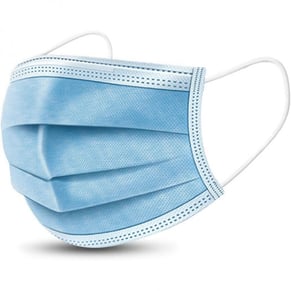
The most general question you’ll want to ask yourself is whether or not you want your masks to be reusable. While it may seem that reusable masks are the obvious choice, there may be situations where a disposable mask is a more advantageous option. Boasting both a low price point and quick turnaround time, 3-ply disposable masks are ideal for protecting a small gathering, event, or meeting both on the fly and on a budget. Each mask is made with non-woven fabrics designed for comfort, including ear loops meant to eliminate pressure on the outer ear.
However, as with all promotional items or branded giveaways, quality is largely tied to pricing, and masks are no exception. These are not hospital or medical-grade masks and are only intended for consumer use. These offer only the bare minimum level of protection compared to some of their reusable counterparts, so these are best used in extremely small or outdoor settings. Additionally, while we can brand these masks if required, these masks are ultimately only available in one color, so these masks are best suited for use when brand guidelines are flexible.
The Neck Gaiter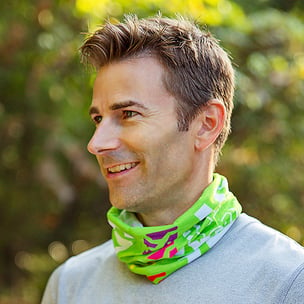
The Gaiter face covering is typically made of a polyester/microfiber blend and is not only extremely comfortable as a result, but also quite easy to breathe through. This type of fabric also provides a wide range of branding opportunities, so this mask is perfect if you’re looking for high brand visibility. Between its ease of use, comfort, and decorating options, this is a popular choice when the mask is intended as a giveaway. The gaiter is not without its shortcomings, though. Much of its comfort originates from the fact that it uses a lightweight blended material that, while perfectly capable of helping prevent particles from being transmitted to the air, does not do a great job of filtering particles that may already be present (though in a low-risk setting where everyone is masked, this is less of a concern).
3-Ply Cotton Masks / Cotton Blends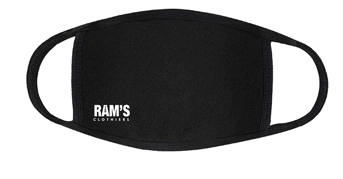
The 3-ply cotton mask is the most commonly used personal mask and is likely the kind that you’ve seen while out and about these past few months. Like the gaiter, these masks are easy to use and easy to decorate, making them another great option for branded giveaways. The 3-ply design of these masks means that it greatly reduces the amount of particulate matter that is released from coughing, sneezing, or talking and offers more protection than the gaiter. These masks are also available in a 2-ply design with a filter pocket. Being able to add a filter to your mask allows for greater resistance to inbound particulate matter and can help to make the mask feel a little easier to breathe through (which is a common complaint for some people in regards to the 3-ply mask). The level of protection provided by both of the 3-ply and 2-ply filter masks is strong and is one of the best you can attain without the use of a medical-grade mask. As such, this is the go-to mask for companies looking to provide their employees with PPE (personal protection equipment) as they return to work. If you’d prefer to prioritize comfort when it comes to these masks, they are available in a cotton/polyester blend. This fabric combination is ultimately more breathable (though, as a result, not as effective as 100% cotton masks as filtering inbound particulate matter).
Clear Masks / Masks with Clear Mouth Area
-11.png?width=323&name=Untitled%20design%20(13)-11.png)
These masks feature the breathable cotton/polyester blend we discussed previously, which allows the mask to include the clear plastic window over the mouth without compromising the safety seal at all. This allows the mouth to be fully visible, yet protected. Not only are transparent face coverings extremely beneficial for deaf and hard of hearing individuals who rely on lip-reading and visual cues, but they present many other benefits as well. See-through masks improve access to vital communication while reducing isolation, loneliness, miscommunication, and confusion. The ability to see facial expressions and emotions is imperative for the development of babies and young children as well as comforting patients experiencing stress, confusion, or anxiety. Receiving an unobscured smile during these uncertain times is enough to boost anyone’s spirit.
Antimicrobial Masks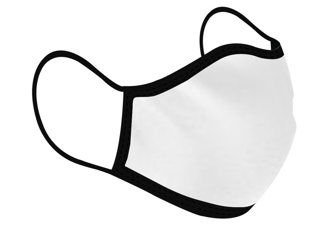
In terms of lightweight masks that are also considered high-tier in terms of protection, another popular option is a 2-ply antimicrobial mask option. These masks are printed on a polyester blend, so they are both extremely comfortable and actually lighter than it’s 3-ply counterpart. A 2-ply, this type of covering would typically offer less protection than a mask with three layers; however, these masks are covered in a silver-based antimicrobial agent that kills most microorganisms or stops their growth. As such, these masks not only offer superb protection but also require a bit less upkeep than a 3-ply mask, which needs to be washed routinely in order to maintain its effectiveness. The method and level of protection provided by these masks, especially when you consider the level of comfort and branding capabilities, does mean that this item is considerably more expensive than both the 3-ply cotton mask and the filtered 2-ply mask. The price tag, however, is well warranted as this is ultimately considered the best protection you can receive from a non-medical grade face covering.
N95 / KN95 Masks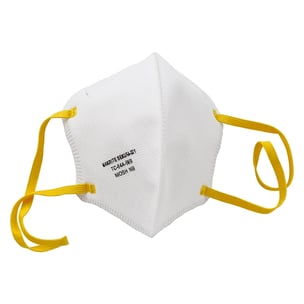
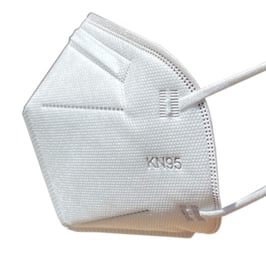
Both the N95 / KN95 are medical-grade masks and filter up to 95% of particles in the air, creating an airtight seal around the wearer’s face. These masks offer the maximum protection possible and are the go-to choice for those in the healthcare industry. The only difference between N95 masks and KN95 masks is how they’re attached to the wearer’s face. The KN95 masks often use the ear loop method of wearing the respirator and is generally considered the easier to use and more comfortable of the two. The N95 masks use two head-strap attachments (one that goes around the back of the head under the ears and another that goes on the top over the crown of the head above the ears), which can create a tighter seal around the face and a greater feeling of protection.
While the level of protection provided by these masks is unparalleled, there are some things to consider before purchasing these. To start, these masks are understandably more expensive than the common 3-ply cotton masks, so unless your event is considered high risk, this is an easy concession to make if you’re looking to save some budget dollars. Another thing to consider here is availability. As this mask is effectively the standard for most of the healthcare industry, stock for this model is much more volatile than types of masks. If your event is in close proximity to the time you’re ordering, stock may not be immediately available, so it is best to order this particular style as soon as you’re sure it’s the model you like. Another potential drawback with this particular mask is the amount of upkeep required to keep it clean and functional. As you can imagine, the filter of these requires special cleaning (instructions are included with the masks), though it is something to be cognizant of when making a decision as not everyone whom the mask is intended for may have access to the cleaning materials needed.
Mask Alternatives and Accessories
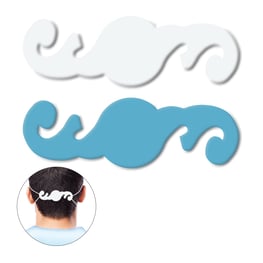
In a situation where masks aren’t available or perhaps not desired, but personal protective equipment is still mandatory, many people are opting for the increasingly popular face shields. Endlessly reusable and easy to clean, the face shield works on two fronts acting as not only a barrier for microbes but for our own hands touching our face as well (which is ultimately one of the tenets of safe, hygienic practices). Its level of protection is on par with the common 3-ply masks, but face shields can also be used in conjunction with a face mask for an added layer of protection. A final (and oftentimes understated) benefit to the face shield is the human element it brings to the table. As the wearer’s face is not concealed in any way, facial expressions and lip movements for speech perception are fully visible. Like the cotton/polyester visible mouth mask, this transparency is especially beneficial for lip-reading accessibility.
Another opportunity to use this mask you may find yourself in is that everyone already has a mask, but you’d still like to provide some type of related giveaway gift. While it’s not unreasonable to expect staff or attendees to have already procured their own masks (especially considering they’re required in public in many states), most people have never explored masks hooks or “ear savers” as they’ve come to be known as. These accessories are small, rubber hooks that allow the elastic bands of the facemask to be comfortably hooked together at the back of the head, ultimately preventing any kind of would-be chafing around the ears. These items are incredibly affordable and can be branded with your company’s logo, making them both a great giveaway gift that is sure to be used well after the event is over or as a “welcome back” gift to your employees in an effort alleviate the inconveniences associated with wearing a mask for extended periods of time at the office.
Assessing Risk Levels
With so many mask options available, choosing the right mask for the job might seem like a daunting task. The easiest questions to ask yourself is how much protection you’re hoping your masks provide and what level of protection is generally recommended for your circumstance. This is also an important question as this characteristic is also the one most closely associated with the price. With many of us operating on reduced budgets this year, it’s important to make concessions where we can in order to keep event costs low and when it comes to masks, one of the easiest ways to do this is to not overstep your protection needs. So what level of protection do you need? The best way to answer this question is to determine the risk level of your event which typically will fall within one of four categories: Lowest risk, More risk, High risk, or Highest risk.
Lowest risk settings are those in which you are not directly interacting with other people. Things like zoom meetings and virtual events would fall under this category. As long as you’re isolated from other people, no mask should be necessary.
More risk settings are gatherings that take place either in an outdoor park, open-air facility, or a well ventilated indoor environment. These types of settings usually pose the smallest threat for infection as long as social distancing guidelines are being observed by all, and as such, people in these environments don’t need to burden themselves with some of the more cumbersome masks. In this scenario, you could opt for disposable masks, a reusable gaiter, or 3-ply cotton masks to get the job done.
Higher risk settings are characterized as a public gathering, using public transit, working in a crowded indoor setting, or working in an area that will have attendees coming from outside locations. Given this description, many offices, retail locations, and event spaces will likely fall under this category. While medical-grade masks will certainly protect you in this setting, comfort is also a priority as these settings typically lend themselves to extended periods of use in regards to masks. For both comfort and protection, the 3-ply cotton mask or face shield are widely recommended and easily the most popular choice for this type of environment.
Highest risk settings are when staff has prolonged exposure to infected patients, is involved with a surgical procedure, or involved with providing care/tests to potentially infected patients. Other highest-risk settings are gatherings in which it is difficult for individuals to remain spaced at least 6-feet apart on top of having individuals coming into this location from outside areas. In this high-risk environment, the N95 and the KN95 masks (as the only medical-grade masks) are really the only options.
Leave it to the Experts
As overwhelming as it may seem to pick the right mask for your particular needs, it really boils down to answering the right questions. How and where you’re planning to use it, whether or not you need it branded, your budget for these types of items, and when you need it will all play a role in determining the perfect mask. The good news is you don’t have to make this decision alone! Our customer relations consultants are well-versed on all our promotional items and are more than happy to do the heavy lifting for you in regards to picking the best face covering. Although our industry’s “normal” has changed, our dedication to helping our customers has not. Together we’ll make it through these uncertain times, and with the right mask, we can do it in style!
Shop Face Coverings or contact us. We would love to help navigate the selection process with you.
Interested in more COVID-19 resources? Checkout our other blogs and resources page!

